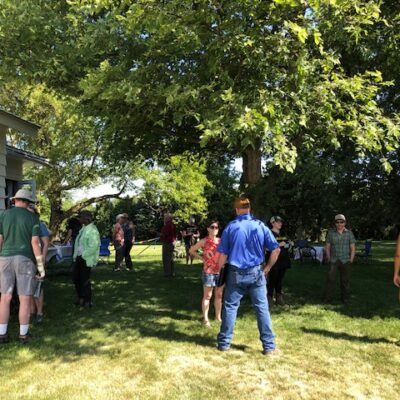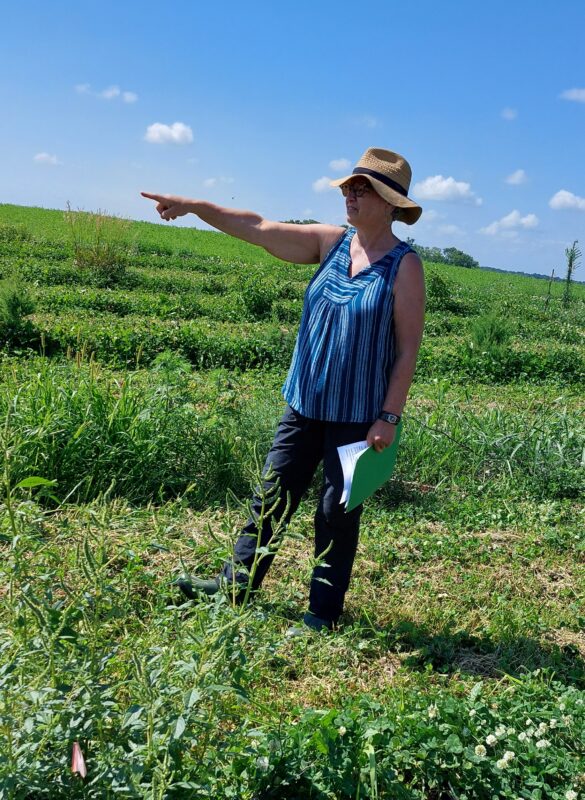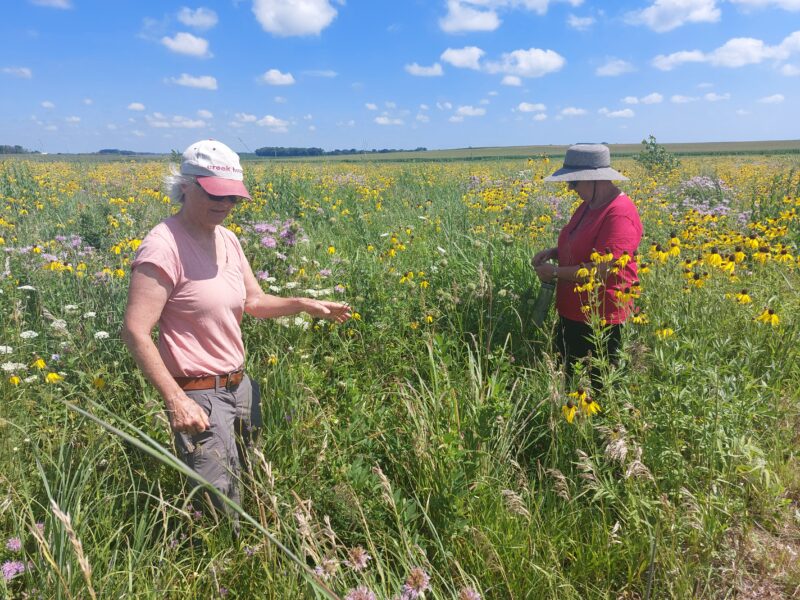On August 5th, Carol and Peg Bouska and their sisters Ann Novak and Sally McCoy (in spirit) treated Climate Land Leaders to a tour of their amazing conservation projects. Here are their remarks from the day.
Our ancestors bought the first plots of this farm in 1903. They continued to add onto this land, purchasing other property until the last 40 acres in the 1980s. Highland Farm is now 450 acres, in two different farms and a five-acre wood lot.
This past year, we sisters committed to learning more about the land’s story and what has happened on this land, to the land itself, and to the people who were here. In looking at some of the farm deeds, we know that plots of this land were sold by the U.S. government to the first colonizers in 1856. This land was inhabited before then by the Ioway, Meskwaki and Sauk, Winnebago (Ho Chunk), Dakota Sioux, and likely others. The Meskwaki tribal nation is the largest still in Iowa, owning 8,100 acres in the Tama area. So we know that history and trauma remains in this land, and isn’t just “in the past”. And we recognize that this understanding is only a first step in addressing the trauma.
We also know that some of the plots purchased in the 1900s were due to foreclosure and forced sales after deaths. Our own ancestors also experienced hardships on this land…. Raising families, losing entire crops, animals and children.
And many joys were had here too…. The extended family gatherings under these trees, the croquet, the bonfires with singing, the playhouse in these woods, the visitors from all over the world, the star gazing and our own memories of growing up here in this place. It’s all here. We want to honor that history too, and that we are continuing to create those experiences and memories with the new generations.
This farm was diverse with corn, oats, alfalfa, beans, cattle, pigs, chickens, sheep, horses, dogs and cats. In the 1980s, with their retirement, our parents rented out the farmland and sold the animals. The farm became a corn and soybean operation. Mom and Dad were concerned about conservation and about their own land legacy and put land in CRP the Conservation Reserve Program], in grassed waterways, filter strips, planted trees, did forestry management and required contour planting with the renter. They also prepared for their deaths with good estate planning.
Our dad was born here and died feet from where he was born.
When he died, we began thinking about our own legacy work. Since then we formed a partnership, where we each own one share, and did much of the legal work to keep the land together. In the last several years we have focused more on the conservation side.

We have committed to transitioning our farm to a regenerative model by 2030. 
Our goals are:
- Increase biodiversity and improve soil, water and air quality
- Use the farmland to help stem the tide of land consolidation
- Provide safe and healthy food
- Keep family harmony
- Contribute to the health of the local community.
Some of our accomplishments that we will see today include:
- Planting of 4,500 trees and shrubs in a windbreak (nine acres).
- Putting in 37 acres of prairie strips around the perimeter of both farms
- Planting three pollinator fields totaling 20 acres
- Restoring a wetland area
How we got here
We so, so often talk about our partners in this work. We would not be here without all of the expertise and support that we are getting. Teresa Opheim got us on the path of our legacy work. We used her workbook and followed her process. Climate Land Leaders, so many of you, have provided inspiration, advice and support. We value this group so much. We have learned so much from our interactions with you… about everything from understanding policy, to deep equity discussions to concrete how-tos on tree protection, and most recently about thistles!
Our helpers – NRCS [Natural Resources Conservation Service] and FSA [Farm Service Agency], U.S. Fish and Wildlife Service and the Iowa DNR [Department of Natural Resources]. Our parents began a great partnership with these groups, and we are so grateful to be the next generation working with their next generation. Gregg Patterson [USFWS] and Brian Sauer [DNR] have literally been here more than we have this past few months, and are always troubleshooting with us. Gregg has gotten us connected with a Luther College class doing their capstone projects and now an Iowa State research project on surveying bumblebees. Matt Frana [NRCS] is now advising us on cover crops and the potential for bioreactors.
Ecological Design created our design and transition plan for our 2030 vision. Paula Westmoreland and Lindsay Rebhan were so easy to work with and opened up a world of possibility that we wouldn’t have imagined. What they gave us was both visionary and concrete and included our desires to respect and support this community. Much of what you will see today is our vision in their design, detailed out by our govt. friends and supported by all of you. It means so much to have you here today.
Windbreaks
Windbreaks have a history on this place. Dad planted silver maples behind the original house here when he was a young man but became dissatisfied with their production. He often said it was a poor decision, because they were not long lived, were relatively soft wood, and often broke at the crotches.
So in 2003, he and Mom decided to plant other trees north of the house. They put in 100 natives, arbor vite and red twig dogwood, which he watered each week, five gallons a week, with a system of hoses. He was in his ‘80s at this time. Mom was proud to say, “We did not lose a one.” They received a conservation award from the county for their effort.
Windbreaks offer such benefits. They protect crops and livestock from wind damage, reduce soil erosion and manage snow deposition, increase carbon storage in biomass and soil, form barriers to chemical drift and noise, provide habitat for wildlife, pollinators and insects, and display year-round beauty.
When we got the Ecological Design plan, it suggested trees for a windbreak around the whole north perimeter of the farm. However, when we consulted tile maps from our files, from our operator and the person who laid the tile, it was clear that tree roots would penetrate the tile lines and disrupt water flow. We decided to limit the windbreak to the west perimeter of the farm north and south of house and a shortened section running east to west on the north boundary line.
We arranged for substituting non-perforated tile on the outlet and disconnected two lines running north/south so that tree root penetration would not bother water flow. This experience brought home the benefit of having a long relationship with the tile operator and our farm operator, both of whom had broad knowledge of the land’s history as well as maps.

To develop the amended windbreak plan, we used Ecological Design suggestions as well as those developed by Brian Sauer from DNR. We elected to have seven rows of trees, all natives that have different life spans and different benefits. Different blooming and fruiting times mean that pollinators, birds and insects have longer season of food, nesting and shelter.
We mulched all 600 legacy trees, and we caged 135 legacy trees.
Challenges have been the white pine, which we had to replant. Plus weeds (thistles, ragweed, buttonweed, amaranth), the logistics and costs of mowing and rabbits. Brian was a great collaborator in developing a detailed plan. He talked with us about what we wanted, suggested varieties we did not know about, clarified spacing and interseeding needs and generally was extraordinarily helpful.
Prairie Strips
We are excited about these impressive findings: According to Iowa State University, research shows that by converting 10 percent of a crop field to diverse, native perennial vegetation, farmers and landowners can reduce sediment movement off their field by 95 percent and total phosphorous and nitrogen lost through runoff by 90 and 85 percent, respectively. Prairie strips provide a win-win scenario for farmers and wildlife.

Prairie strips were included in the USDA cost share program in the last couple of years, thanks to many of the folks at ISU. This was the final impetus for our decision to initiate this CRP program. We had hoped to plant the strips intermittently throughout the fields for the highest benefits, but this was not convenient for our operator’s equipment. Instead, we decided on 37 acres on the periphery of the farms. He was happy with this as it allowed him a turn around on the edges of the field, 75 foot being a good width. This allows for a corridor for wildlife to include the windbreak on the north and west all the way around to the wetland.
NRCS and FSA were very helpful in the planning with mapping and flagging. Brian and Gregg helped us decide on a seed mix. The goal was to plant as late as possible in the Fall before a snow. We hired that done with a local guy who planted our pollinator fields and works with CRP guidelines regularly. He was able to do it right before Thanksgiving.
We will likely need to mow at least 3 times this summer. CRP cost share covers two mowings. Gregg with FWS added 16 varieties to the mix so we ended up with 52 varieties of forbs and seven of grasses.
Pollinator Field
In 2013, Tom helped us decide where to place a new pollinator area. This spot was less valuable to him due to the size, difficulty in turning around, wetness, etc. The wetland on the Northeast area had already been established. We researched options with NRCS. Our brother Jack took that on and became very invested and excited about the project and the goal to increase biodiversity and habitat for insects and birds–the pollinators. Jack died suddenly in Sept 2014. We had planned to seed this pollinator field in Spring 2015. We did that and named it Jack’s Field. We had a ritual to spread some of his ashes here with his family and it has been a great comfort to all of us to watch it progress.

We did the required mowing several times per summer for the first two years, and we did a burn at approximately year five. That burn was not ideal as it was a wet spring and it was hard to get it done before the deadline May 15. That poor burn is possibly contributing to the poplars that we will need to deal with this fall. From various sources we’ve asked regarding management, it seems that cutting them down at the base and dabbing with a specific herbicide is the best strategy. We’ve also battled the thistles, trying to mow them after flowering and before seed spread, which affects their energy source maximally.
Wetland
This area was in a “wetland” CRP since 2002. It was in tall grasses and often had sitting water but it was shallow. Volunteer willows and box elders became quite a maintenance issue for us. We had to control them with cutting, treating and burns, but the burns were not always effective because of the standing water.
Paula and Lindsay of Ecological Design had this area dedicated to a “pond” in our future design. We also realized that there was no water on this farm for the wildlife that we were trying to draw and protect. Our NRCS office developed the plan and we hired the excavation company run by our old neighbor, Marty Jestrab, and his son, Brian. It was great to have them doing this work for us.
We couldn’t use CRP funds for this project because it was already in a CRP, but we decided to do it anyway. Gregg was able to get some grant funding to help us install a regulator (which controls the water level) and to add to the diversity of the mix on the dike and shore.
This entire farm is tiled. The tile from the top of that hill all drains to this area. Before this excavation, the tile drained out to tile in the field here to the north. Brian, Gregg and Dan Mohn [NRCS] worked with our excavation crew last October to basically allow the tile lines draining from our farm to go into an excavated area (protected by the dikes), rather than drain out into the tile lines to the north. So essentially, the tile lines under this area were removed.
There is an 8-inch pipe running from the pool, under this dike and into this intake unit. The intake runs into the tile lines in the neighbor’s field, the same tile lines that the original lines were feeding into. The level of the pool can be regulated with boards that basically serve as a dam.

Our challenges right now are that when we get heavy rain, the intake cannot keep up with the amount of water coming in through the pipe. When that happens, the backup of water goes up this ditch area and flows into our neighbor’s fields. If we slow the water flowing out of the pool, by creating a dam with the boards, then this first year especially, we compromise the vegetation on the banks of the pool. This is a dilemma that we are still working on. We are trying to figure out how to make this work for us, and for the neighbors.
Brian, Gregg, Dan and the Jestrabs are all still committed to making this work and are out here often monitoring what is happening after rain events especially. We also want to recognize that we built an artificial boundary on “our” property, this dike, within a natural wetland. This whole area is wetland.
In this first three seasons, we have seen many animal tracks, evidence of this being a valuable watering hole. We have seen and heard many frogs, tadpoles and pollywogs, eagles, migrating geese, ducks and shore birds, and Brian and I saw a great blue heron flying this way on our way back to the farm one day. The pollinator field abuts this area and you can also see that the neighbors have grazing here. We have seen bobolink and heard meadowlarks here.
Paula and Lindsay say that wetlands are the kidneys of the land, cleaning and filtering water of nitrogen and chemicals. Wetlands also sequester carbon, provide wildlife and increase biodiversity.
We are so happy to have this wetland on the farm. Thank you, Paula, Gregg, Brian and our partners for making this happen. This would not be here without each of you. Really.